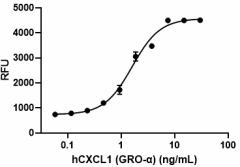- Regulatory Status
- RUO
- Other Names
- FSP, Grow regulated oncogen 1 (GRO1), Grow regulated oncogen a (GRO a), melanoma growth stimulating activity (MGSA), MGSA-a, neutrophil activating protein 3 (NAP-3), SCYB1

-

Recombinant human CXCL1 (GRO-α) induces the chemotaxis of mouse Baf3-mCXCR2 transfectant cells in a dose-dependent manner with ED50 range of 1 - 5 ng /mL. -

Bioactivity was measured by its property to chemoattract human neutrophils in a dose-dependent manner.
| Cat # | Size | Price | Quantity Check Availability | ||
|---|---|---|---|---|---|
| 574402 | 10 µg | $112.00 | |||
| 574404 | 25 µg | $223.00 | |||
| 574406 | 100 µg | $703.00 | |||
| 574408 | 500 µg | $2109.00 | |||
Select size of product is eligible for a 40% discount! Promotion valid until December 31, 2024. Exclusions apply. To view full promotion terms and conditions or to contact your local BioLegend representative to receive a quote, visit our webpage.
The CXCL1 gene was initially identified by its constitutive overexpression in spontaneously transformed Chinese hamster fibroblasts, and the CXCL1 protein was originally purified as an autocrine growth factor from supernatants of a human melanoma cell line. CXCL1 is frequently overexpressed in many cancers, such as breast cancer, ovarian cancer, colorectal cancer, prostate cancer, and squamous cell carcinoma. CXCL1 is an ELR CXC chemokine, and it is structurally and functionally related to GRO2 (CXCL2), GRO3 (CXCL3), and interleukin-8 (CXCL8). CXCL1, CXCL3, and IL-8 bind to the CXCR2 receptor with CXCL1 (GROα) having the highest affinity. CXCL1 is crucial for the recruitment of neutrophils to inflammatory sites. In addition, CXCL1 has pleiotropic effects on cell proliferation, tumor angiogenesis, invasion, and metastasis. Thrombin enhances the secretion of CXCL1 from tumor cells, and these two molecules together induce vascular regulatory proteins and growth factors involved in angiogenesis; this parallels activity of VEGF, Ang-2, CD31, KDR, CXCR2, MMP1, and MMP2 in HUVEC cells. In addition, PGE2 stimulates expression of CXCL1 in human colorectal carcinoma cells through activation of an EGFR-MAPK. Furthermore, CXCL1 (secreted by CRC cells) induces endothelial cell migration and tube formation in vitro and in vivo. CXCL1 is induced by inflammatory cytokines such as IL-1 and TNF. In addition, IL-17A enhances expression of CXCL1 by prolonging the half-life of its constitutively unstable mRNA.
Product Details
- Source
- Human CXCL1, amino acids Ala35 -Asn107 (Accession # NM_001511.2) was expressed in E. coli.
- Molecular Mass
- The 73 amino acid recombinant protein has a predicted molecular mass of approximately 7.8 kD. The DTT-reduced protein migrates at approximately 10 kD and non-reduced protein migrates at slightly higher than 10 kD by SDS-PAGE. The N-terminal amino acid is Alanine.
- Purity
- >98%, as determined by Coomassie stained SDS-PAGE.
- Formulation
- 0.22 µm filtered protein solution is in PBS.
- Endotoxin Level
- Less than 0.01 ng per µg cytokine as determined by the LAL method.
- Concentration
- 10 and 25 µg sizes are bottled at 200 µg/mL. 100 µg size and larger sizes are lot-specific and bottled at the concentration indicated on the vial. To obtain lot-specific concentration and expiration, please enter the lot number in our Certificate of Analysis online tool.
- Storage & Handling
- Unopened vial can be stored between 2°C and 8°C for up to 2 weeks, at -20°C for up to six months, or at -70°C or colder until the expiration date. For maximum results, quick spin vial prior to opening. The protein can be aliquoted and stored at -20°C or colder. Stock solutions can also be prepared at 50 - 100 µg/mL in appropriate sterile buffer, carrier protein such as 0.2 - 1% BSA or HSA can be added when preparing the stock solution. Aliquots can be stored between 2°C and 8°C for up to one week and stored at -20°C or colder for up to 3 months. Avoid repeated freeze/thaw cycles.
- Activity
- Recombinant human CXCL1 (GRO-α) induces the chemotaxis of mouse Baf3-mCXCR2 transfectant cells in a dose-dependent manner with ED50 range of 1 - 5 ng /mL. Bioactivity was also measured by its property to chemoattract human neutrophils in a dose-dependent manner.
- Application
-
Bioassay
- Application Notes
-
BioLegend carrier-free recombinant proteins provided in liquid format are shipped on blue-ice. Our comparison testing data indicates that when handled and stored as recommended, the liquid format has equal or better stability and shelf-life compared to commercially available lyophilized proteins after reconstitution. Our liquid proteins are verified in-house to maintain activity after shipping on blue ice and are backed by our 100% satisfaction guarantee. If you have any concerns, contact us at tech@biolegend.com.
- Product Citations
-
Antigen Details
- Structure
- Chemokine
- Distribution
-
CXCL1 is produced by neutrophils, activated monocytes, fibroblasts, epithelial cells, and endothelial cells.
- Function
- CXCL1 chemoattracts neutrophils and induces cell proliferation, tumor angiogenesis, invasion, and metastasis. CXCL1 is induced by IL-1, TNF, thrombin, and PGE2.
- Interaction
- Neutrophils and endothelial cells.
- Ligand/Receptor
- CXCR2
- Biology Area
- Cell Biology, Neuroinflammation, Neuroscience
- Molecular Family
- Cytokines/Chemokines
- Antigen References
-
1. Anisowicz A, et al. 1987. P. Natl. Acad. Sci. USA 84:7188.
2. Caunt M, et al. 2006. Cancer Res. 66:4125.
3. Wang D, et al. 2006. J. Exp. Med. 203:941.
4. Datta S, et al. 2010. J. Immunol. 184:1484. - Gene ID
- 2919 View all products for this Gene ID
- UniProt
- View information about CXCL1 on UniProt.org
